DIFFERENT LEVELS OF SOPHISTICATION IN SPARRING AND FIGHTING -- OVERVIEW
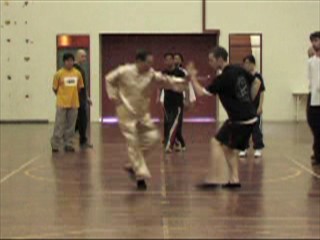
Some high level sparring using sequences and tactics
Sparring and actual fighting may operate at the following levels of sophistication:
- random-level
- technique-level
- sequence-level
- tactic-level
- strategy-level
The lowest level is that of haphazard fighting, where combatants hit each other randomly. Kungfu sparring has been debased so badly that today this is the level many kungfu practitioners operate at.
Kungfu masters in the past operated at much higher levels. They did not throw away their kungfu forms and punched and kicked randomly. Not only they used kungfu techniques individually, they linked them into meaningful sequences. Further, they employed principles, tactics and strategies to enhance their fighting efficiency, and generalized particular advantageous ways of fighting into combat principles.
The progression from random fighting to using techniques to tactics and to strategies represents the development of combat sophistication over many centuries. At first people fought randomly. Then they discovered that certain ways of fighting were advantageous, and these were stylized into techniques. As they became more sophisticated in combat, they discovered that using techniques in some particular ways was more advantageous than using techniques at random. This led to the use of tactics and strategies.
From their fighting experiences, past masters formulated principles from their applications of techniques, tactics and strategies. For example, instead of executing a kick straight-away, they found it more effective by first throwing a punch, and when the opponent responded to the punch, they executed a kick. They often gave poetic descriptions to such combat principles, and this example is called “Sound the East, Strike the West”. Hence, by understanding such principles and applying them, we benefit much from the experiences and teachings of past masters.
We must also remember that when we fight at a higher level of sophistication, it does not necessary mean we will defintely win the combat. An opponent who operates at a low level of sophistication but is very skillful may be victorious. As an analogy, a skillful cyclist may travel faster than a driver of a car if he is incompetent in driving.
But if all other things were equal -- even when they are not equal but the difference in skills is not too great -- a combatant operating at a higher level of sophistication certainly has many advantages over his lower level opponent.
The video series here shows some examples of these principles, tactics and strategies at high levels of combat sophistication.
Changing from One Sequence to Another
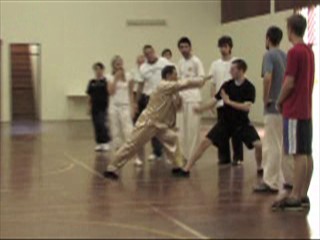
If you use sequences in combat, you operate two levels higher than an opponent who spar or fight randomly. This is Combat Sequence 10, which is called “White Horse Presents Hoof”, after the name of the kicking pattern. This sequence is a development from Combat Sequence 9. If your opponent does not move in to attack you when you offer a false exposure, or if he hesitates in any way, you may change from Sequence 9 to Sequence 10 by moving in with a thrust kick.
Some Important Combat Principles

Sequence 9 is performed slowly to show some important combat principles. Your opponent counters the kick with the pattern “Save the Emperor with Single Whip”, applying the tactic of “no-defence-direct-counter”, As you move in to attack the opponent's throat after avoiding his Single Whip, it is important to “tame” his hand.
Neutralizing an Opponent's Advantages
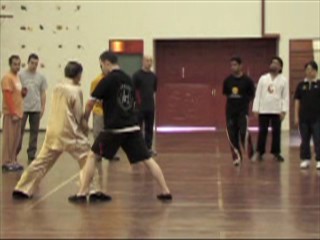
The initiator's and the responder's roles are now reversed. You can employ “shen-fa” or body-work to neutralize an opponent's closure on you. Not only you can release yourself from an awkward position, you may also reverses the technical advantage of the situation. These movements in neutralizing an opponent's advantages are impromptu.
Using Sequences in Sparring
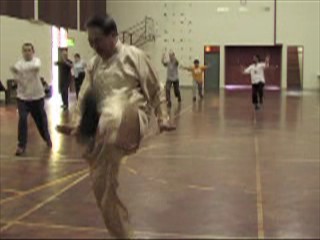
The initiator's mode for Combat Sequence 10, which is called “White Horse Presents Hoof” after its kicking pattern, is now performed. Solo practice is a good way to ensure that you can apply your techniques smoothly in a sequence for combat. Using sequences in sparring or fighting, of course, gives you many advantages over haphazard sparring and technique sparring.
Advantages of Picture-Perfect Forms
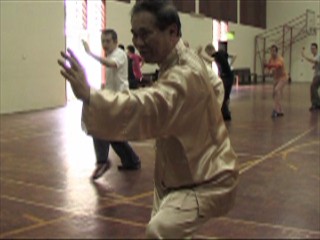
This is the responder's mode of Combat Sequence 10. Notice that the forms are picture-perfect. Having picture-perfect forms will give you many advantages in combat. Many techniques may not work if the forms are not picture-perfect. Solo practice is a good way to develop picture-perfect forms.
Lacking in Jing, Qi and Shen
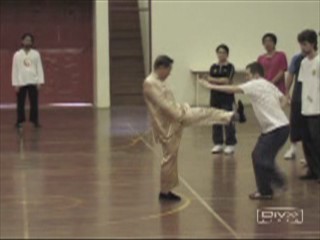
Here is an example of what you should not do. The sequence is purposely performed poorly. There is little elegance, force and presence of mind. In other words, the internal harmonies of “jing”, “qi” and “shen” are lacking.
Element of Threat in Attack
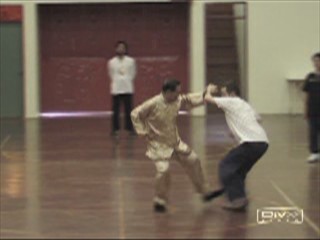
This is how kungfu should be performed -- with the six harmonies of feet, body, hands, elegance, energy and mind. Although the patterns are the same as those shown in the previous video, the performance here is vastly different. It contains an element of threat, which is important in an attack.
The Method of Continuation
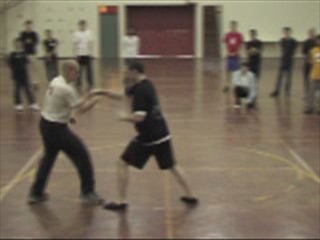
Using combat sequences is more sophisticated than using individual techniques, which in turn is more sophisticated than fighitng haphazardly. After completing one sequence, you may continue with the same or another sequence. You can start with Sequence 9 or Sequence 10, which incorporate kicking attacks, and continue with any one of Sequences 5 to 8, which use the right leg mode and a variety of hand attacks. Something is lacking here. Do you know what it is? The next video will give the answer.
Speed and Force in Element of Threat
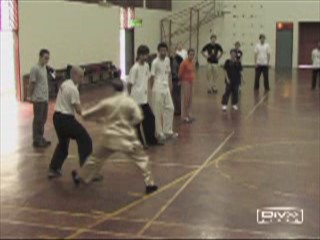
What is lacking in the attack shown in the previous video is an element of threat. The opponent does not feel threatened by the attacker. It is not because an opponent does not know how to defend against the attack, but the attack comes in with such speed and force, which constitute the element of threat here, that is the opponent overwhelmed.
Helping One Another in Sparring
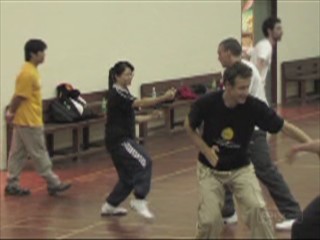
Participants practice free sparring using the combat sequences they have just learnt. It is worthy of note that unlike in many other schools, in Shaolin Wahnam sparring is not only injury free but is full of fun. Participants help one another and not attempt to out do each other. Though the attack is threatening, it is under full control and no one is hurt.
LINKS
Review of the Intensive Shaolin Kungfu Course in Sabah in March 2007
- Overview 1 : The Fundamentals
- Overview 2 : The 16 Combat Sequences
- Overview 3 : Are They Performing Kungfu Dance?
- The Basics of Shaolin Kungfu Training
- Fundamental Combat Skills
- Defeat you Hand to your Opponent, Victory you Create Yourself
- Avoiding Disadvantages and Seeking Advantages
- Basic Principles and Tactics of Combat
- Skills derived from Sparring can be Rewardingly used in Daily Life
- Some Secrets in Practicing Genuine Kungfu
-
Various Ways to Move into an Opponent
- Applying Combat Sequences in Sparring
- Linking Sequences to be More Combat Efficient
- The Secrets of Continuous Cannons
- The Mechanics of Continuation
- Marvelous Techniques Beget Marvelous Techniques
- Perfecting Forms and Developing Force
- Applying Tactics in Combat
-
Objectives of Form Training in Solo
- Being Fluent in Kicking Techniques before Applying them in Combat
- Using Tactics in Kicking Attacks and Defences
- Different Levels of Sophistication in Sparring and Fighting
- The Legacy of Uncle Righteousness: Secret of Continuous Cannons and their Counters
-
Benefiting from the Experiences and Teachings of Past Masters
- Poetic Patterns Can be Very Deadly
- Moving Back One Step when in Diffiuclt Situations
- Linking Sequences to Form a Kungfu Set
- Felling Techniques in Kungfu are Different from Judo and Wrestling
- Butterfly Palms and Hiding Flowers are Excellent in Countering Felling and Gripping Attacks
-
Let Mercy Flow from the Hands
- Benefits of Solo Set Practice — Combat Sequences 13 to 16
- From Pre-Choice Sequences to Free Sparring
- Applying Shaolin Patterns Correctly and Spontaneously in Free Sparring
- Shaolin Kungfu against Boxing and Kick-Boxing
- Shaolin Counters against Wrestling Shoots
- The Secret of Grandmaster Ho Fatt Nam
- Why Shaolin Kungfu is Technically Faster than Boxing
- Shaolin Techniques, Tactics and Strategies against Boxing
- Revealing Secrets of Past Taijiquan Masters
- Overwhelming Opponents with Just One Pattern
- Poetry and Elegance in Effective Combat
